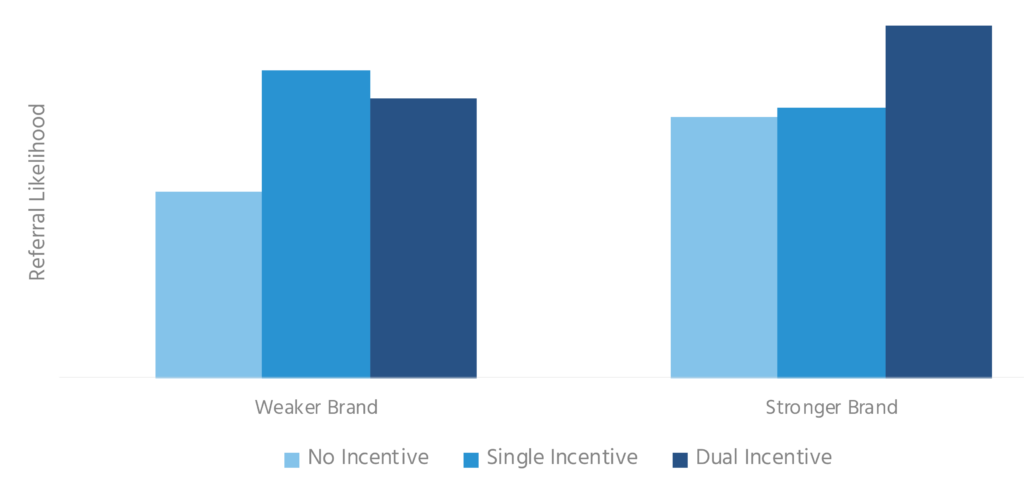If you want an effective referral program…
Start with a compelling referral offer.
Here’s the thing – A referral offer that works well for one contractor may fall flat for another. If you choose the wrong structure for your referral offer, you could end up overpaying for referrals and saddling your team with administrative tasks that they don’t have time to complete.
This article breaks down the two most common approaches that solar and energy efficiency contractors use to structure their referral offers. You’ll understand when to apply each approach so that you can confidently choose an offer, which drives you forward and doesn’t hold you back.
All for one or one for all?
At a glance, the two approaches are to either give the full referral bonus to one person or split the bonus between two people.
- Single incentive referral offer: Give the entire cash bonus either to the person who gives the referral (more common) or the person who receives the referral (less common).
- Dual incentive referral offer: Split the cash bonus between the person who gives the referral and the person who receives the referral. Most do a 50 / 50, but you could choose another percentage.
Pros and cons of the single incentive
PRO: Less expensive. Most solar contractors pay between $500 and $1,000 for a referral. Efficiency contractors typically pay between $100 and $200. If you want to stay on the lower end of the range – keeping your expenses down while still inspiring referrals – you should offer the full cash bonus to the person who gives the referral.
By paying only one bonus rather than two, you’ll limit customer acquisition costs and protect your margins.
PRO: Easier to manage. When you choose a single incentive referral offer, you only have to track and pay one bonus. This allows you to effectively cut your administrative work in half compared to a dual incentive referral offer. Either way, we’re not talking about a huge amount of administrative work, but if you have a small team, you need to pay attention to every new commitment that you make.
PRO: More effective for small or newer contractors. If people are relatively unaware of your company, then it’s fair to say that you have a weaker brand compared to larger companies like SolarCity or Sunrun. Companies with weaker brands are likely to earn more referrals from a single incentive referral offer.
The reason is that customers generally feel less confident in companies with weaker brands. To close the deal or inspire the referral, pricing and cash incentives play a more prominent role.
Dr. Lawrence Feick at the University of Pittsburgh and his colleagues have done some really interesting research on the top of brand strength and referral likelihood. Check out their article in the Journal of Marketing: “A Penny for Your Thoughts: Referral Reward Programs and Referral Likelihood.”
Relative Effect of Referral Structure and Brand Strength on Referral Likelihood

CON: Monetizing friends and family. A single incentive referral offer can rub some clients the wrong way. If you pay the full referral bonus to your client and offer nothing for the people that they refer, then the client could feel that they’re profiting unfairly from their friends and family. I don’t see this as a deep or widespread concern, but it has the potential to hurt your brand with some clients.
One way to address monetization: Here’s what I recommend if you’re inclined to go with a single incentive referral offer but want to avoid concerns about monetization.
Your standard offer will make it clear that you’re only paying a bonus to the person who gives the referral. However, when you first introduce the offer to your clients, let them know that for a limited time, you’ll give something extra to any friends or family that they refer.
As a general rule, people feel more motivated when they see something of value that they stand to lose if they fail to take action. This approach will deliver better results for your referral program, and in part, you’ll alleviate some clients’ concerns about benefiting at the expense of their friends or family.
There’s much more to say about limited-time incentives, which I’ll come back to the topic in a later article.
Pros and cons of the dual incentive
PRO: Everyone wins. This is perhaps the biggest benefit of the dual incentive referral offer. You create a situation where everyone wins. Your clients refer their friends and family because they get a generous bonus, and the people that they refer get a significant discount.
PRO: More effective for strong brands. If you’re a larger or well established contractor in your market, you should choose a dual incentive structure. Recall the research by Feick and his colleagues. Data shows that companies with stronger brands tend to get better results from their referral programs when they split the referral bonus between the person who gives the referral and the person who receives it.
What’s the rationale here? In general, customers see companies with stronger brands as offering higher quality products and services. They feel more confident in these companies and hence tend to make choices based more on personal preferences rather than budget limits.
CONS: More expensive and more to manage. When paying two bonuses rather than one, you’ll pay more for customer acquisition, and you’ll face twice the administrative burden. That said, both challenges are surmountable for an established contractor with an organized team.
Remember that referrals are the gold standard of lead generation. Referrals tend to show the best conversion rates of any leads in the solar or energy efficiency markets, so doing what you can to maximize your referrals (within reason) will benefit your bottom line.
At the end of the day
For small and mid-sized contractors, I recommend paying the entire referral bonus to the person who gives the referral. Go with a limited time incentive for the person who gets the referral to alleviate concerns about benefiting unfairly from friends and family.
Larger solar and energy efficiency contractors, you’ll see better results by splitting your referral bonus between the person who gives the referral and the person who receives it.


